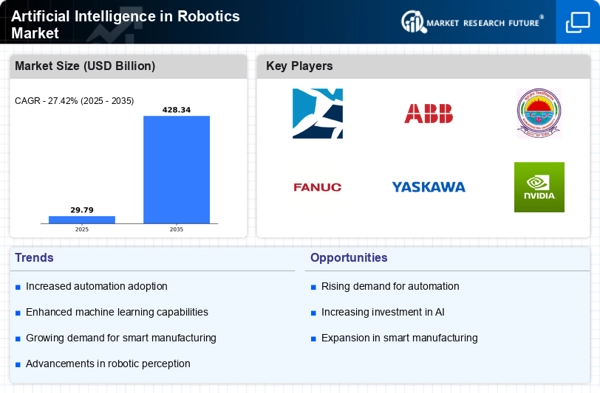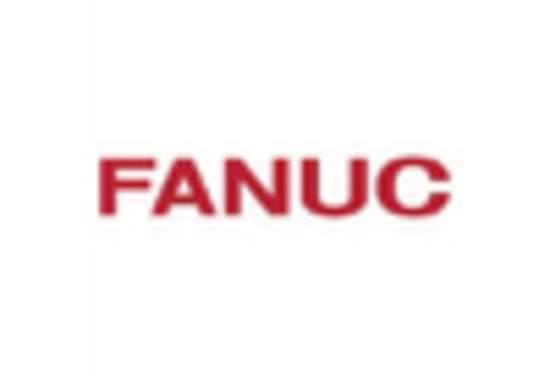Rising Demand for Automation
The increasing demand for automation across various sectors is a primary driver of the Artificial Intelligence in Robotics Market. Industries such as manufacturing, logistics, and healthcare are increasingly adopting robotic solutions to enhance efficiency and reduce operational costs. According to recent data, the automation market is projected to grow at a compound annual growth rate of over 20% in the coming years. This trend indicates a robust appetite for AI-driven robotics, as organizations seek to streamline processes and improve productivity. The integration of AI technologies into robotics allows for more sophisticated automation solutions, enabling machines to perform complex tasks with minimal human intervention. As businesses recognize the potential benefits of automation, the demand for AI in robotics is likely to surge, further propelling the market forward.
Advancements in AI Technologies
Technological advancements in artificial intelligence are significantly influencing the Artificial Intelligence in Robotics Market. Innovations in machine learning, computer vision, and natural language processing are enhancing the capabilities of robots, making them more intelligent and adaptable. For instance, the development of deep learning algorithms has enabled robots to learn from vast amounts of data, improving their performance in real-time applications. The market for AI technologies is expected to reach substantial figures, with estimates suggesting a growth rate of approximately 30% annually. This rapid evolution in AI capabilities is likely to drive the adoption of robotics across various sectors, as organizations seek to leverage these advancements to gain a competitive edge. Consequently, the synergy between AI and robotics is anticipated to create new opportunities and applications, further expanding the market.
Expansion of Robotics in Emerging Markets
The expansion of robotics applications in emerging markets is a notable driver of the Artificial Intelligence in Robotics Market. Countries in Asia, Africa, and Latin America are increasingly adopting robotic solutions to address challenges such as labor shortages and inefficiencies in traditional processes. The robotics market in these regions is expected to grow at a rapid pace, with projections indicating a growth rate of over 18% annually. This trend is fueled by the rising awareness of the benefits of automation and AI technologies. As emerging markets continue to develop their industrial capabilities, the integration of AI in robotics is likely to play a pivotal role in enhancing productivity and competitiveness. Consequently, the expansion of robotics in these regions presents significant opportunities for growth within the market.
Increased Investment in Robotics Research
The surge in investment directed towards robotics research and development is a crucial driver of the Artificial Intelligence in Robotics Market. Governments and private entities are recognizing the strategic importance of robotics in enhancing economic competitiveness and innovation. Recent reports indicate that funding for robotics research has increased by over 15% annually, reflecting a growing commitment to advancing robotic technologies. This influx of capital is facilitating breakthroughs in AI integration, enabling the development of more sophisticated and capable robotic systems. As research continues to evolve, the potential applications of AI in robotics are expanding, ranging from autonomous vehicles to advanced manufacturing solutions. This trend suggests that sustained investment in robotics research will likely yield significant advancements, further propelling the market's growth.
Growing Need for Enhanced Safety and Precision
The increasing emphasis on safety and precision in various industries is driving the demand for AI-powered robotics. In sectors such as healthcare, construction, and manufacturing, the need for accurate and safe operations is paramount. The integration of AI technologies into robotics enhances their ability to perform tasks with high precision, thereby reducing the risk of errors and accidents. For example, AI-driven surgical robots are revolutionizing the healthcare sector by enabling minimally invasive procedures with greater accuracy. The market for precision robotics is projected to grow significantly, with estimates suggesting a rise of around 25% in the next few years. This growing need for enhanced safety and precision is likely to propel the adoption of AI in robotics, as organizations seek to improve operational standards and outcomes.

















Leave a Comment